Parser documentation
✨Welcome✨
As you might already know, the Penrose system has two extensible DSLs. Therefore, in our implementation, we have two parsers for Substance and Style.
We use a parser combinator library, Megaparsec, to build the parsers. This library builds on top of the Parsec library. For starters, you can follow the blog posts on Megaparsec:
Parsing a simple imperative language Beginner's guide to Megaparsec
Megaparsec is a parser combinator, which is another popular type of parser other than parser generators (yacc is an example of a parser generator). A couple special things about parser combinators:
- By default, there is no explicit lexing stage in the compiler. Instead, lexical analysis is done during the parsing phase. (Megaparsec claims to support output from
alex, a lexer library in Haskell, but we never tested it) - You essentially write small parser functions and "glue" them together in a bigger function. In Haskell, you connect these little parser functions by applicatives. (I'm not going to all the Haskell details here)
- Why a parser combinator? (Katherine's answer from Slack)
- Comparison of parser combinators vs. parser generators. https://softwareengineering.stackexchange.com/questions/338665/when-to-use-a-parser-combinator-when-to-use-a-parser-generator
- Using a parser generator requires writing the grammar in another DSL, which not Haskell. So we'd need to keep two copies of the grammar around, one in e.g. Happy (the Haskell library's DSL), one in Haskell. But the parser is directly generated from the grammar, which is a nice, direct approach.
- Identifiers must start with a letter ([A-Za-z]) and followed by alphanumeric characters.
- Names that start with an underscore character (
_) is reserved by the compiler- For now, the use of these name is for a Substance object that does not have an explicit name. For example,
Subset A Bmathematically describes a relation between twoSet, but is treated as an "object" (TODO: using the term loosely. Katherine refer to them as "constraints" in earlier documents) in the system, i.e. you can associate shapes with this object - as shown inTOP/src/sty/tree.sty. - In this case, the system internally creates an identifier for a constraint (see
getConstrTuplesinStyle.hsfor implementation), which essentially concatenates the statement string and adds an_before the string. (Subset A B➡️_SubsetAB)- TODO: Probably not the best implementation, any more principled way?
- For now, the use of these name is for a Substance object that does not have an explicit name. For example,
- Keywords
- Optimization
avoidconstraintobjective- Note that in the DSLDI paper, we used
ensureandencourage, but in development we are still usingconstraintandobjective. This can be easily changed in the parser if needed.
- Selectors
global
- Classes of graphical primitives
ColorNoneAutoArrowTextCircleCurveEllipseBox
- Primary shape of a Substance object:
shape
- Optimization
- Reserved words
- Inside of constructors (e.g.:
Arrow { start = xx; end = xx})- To properly construct a graphical primitive, a set of parameters are often required. Different primitives often require different sets of parameters.
- The exact set of parameters are determined by the
init*functions inRuntime.hs, where each function callsqueryCondig_*to look for values associated with certain reserved words. - For example, an Arrow requires
startandend. Optionally, you can providelabel, too. - TODO: this implementation does not scale. Therefore, we are working on a more generalized version.
- Optimization/Computation
- Depends on the state of the style and computation dictionaries. All entries in these dictionaries are reserved words.
- See
Computation.hsandFunctions.hsfor the dictionary entries
- See
- Depends on the state of the style and computation dictionaries. All entries in these dictionaries are reserved words.
- Inside of constructors (e.g.:
-
Each Style block begins with a list of selectors separated by commas
-
A selector can either be
globalor typed- Global selector:
global- Matches with all Substance identifiers
- This is primarily for testing purposes. It gives exactly one selection. You can declare some "global objectives" and be sure that only one copy of it will be in the system.
- To elaborate, you technically have access to all Substance identifiers everywhere, but if you do
Set X { objective A onTop B }, there could be multiple copies ofonTopbecause you might match multipleSets.
- Typed selector is a type signature followed by a list of arguments (called
Patternin the AST)- Two patterns of matching exist: quoted matching and binding matching. The composition of them is also allowed
-
Quoted matching:
Set `A`- Matches on one particular Substance object
- Search for the identifier enclosed by backticks among all identifiers declared in the accompanied Substance program.
- Example
- Substance:
Set A- Style:
Set `A` { shape = Circle { color = computeColorRGBA(0.1, 1.0, 0.2, 0.4) -- green } constraint contains(A, A.label) }- Output:
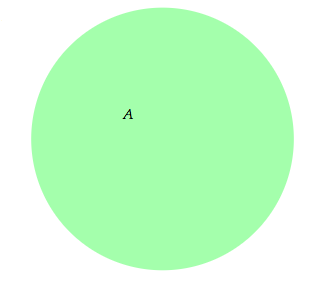
-
Binding matching:
Set A- Matches on all Substance objects with the same type
- Example
- Substance:
Set A Set B- Style:
Set x { shape = Circle { color = computeColorRGBA(0.1, 1.0, 0.2, 0.4) -- green } constraint contains(x, x.label) }- Output:
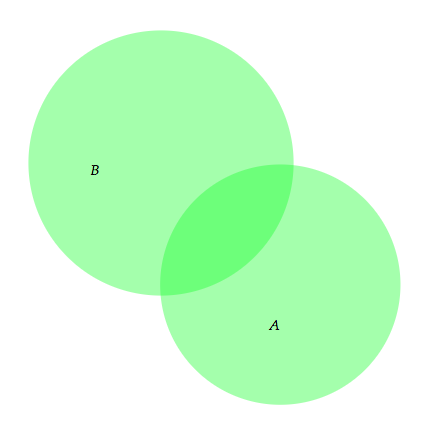
-
Composed matching:
- The above matching can be mixed together.
- Mixing binding matching with quoted matching within a selector
- Example:
Subset A `B`selects all subsets ofSet `B`
- Example:
- Example: FIXME does not work properly yet
Subset x `D` { x.color = computeColorRGBA(0.1, 1.0, 0.2, 0.4) -- green constraint contains(y, x) constraint smallerThan(x, y) constraint outsideOf(y.label, x) } Set x { shape = Circle { } constraint contains(x, x.label) }
- Global selector:
-
What does it mean to have multiple selectors?
- A Cartesian product among selected objects will be computed, and the combinations that produce inconsistent mappings will be discarded
- Consider the following program
-- Substance Set A, B, C, D -- A, B and C are both subsets of D Subset A D Subset B D Subset C D -- Style Subset x S, Subset y S { objective repel(x, y) }- Each of
Subset x SandSubset y Smatches allSubsetobjects in Substance. The Cartesian product (3 * 3 = 9 combinations) will be:Subset A D, Subset A DSubset B D, Subset B DSubset C D, Subset C DSubset A D, Subset B DSubset B D, Subset A DSubset A D, Subset C DSubset C D, Subset A DSubset B D, Subset C DSubset C D, Subset B D
- We then filter the Cartesian product to remove any inconsistent pairs. By inconsistent, we specifically mean that there should not be two aliases binding to the same Substance id. For example,
Subset A D, Subset A DbindsxandytoA, which is not allowed. (seeisOneToOneunderprocBlockinTOP/src/Style.hsfor source code). - After filtering, the following matched pairs remain:
Subset A D, Subset B DSubset B D, Subset A DSubset A D, Subset C DSubset C D, Subset A DSubset B D, Subset C DSubset C D, Subset B D
- The following objective functions are generated:
repel(A, B)repel(B, A)repel(A, C)repel(C, A)repel(B, C)repel(C, B)
- A live example:
TOP/src/sty/tree.sty
-- tree.sub Set A, B, C, D, E, F, G Subset B A Subset C A Subset D B Subset E B Subset F C Subset G C NoIntersect E D NoIntersect F G NoIntersect B C -- tree.sty Set x { shape = Text { text = None } } Subset x y { objective above(y, x) objective sameX(x, y) shape = Arrow { start = x.shape end = y.shape text = None } } -- each set repel others to spread out the tree Set x, Set y { objective repel(x, y) } -- nodes (sets) on the same depth in the tree have the same y values Subset x S, Subset y S { objective sameHeight(x, y) }-
Subset x S, Subset y S { ... }generates objectives that force nodes on the same level in a tree to stay on the same height -
Set x, Set y { ... }imposes objectives that make each node repel all other nodes, therefore "stretching" the tree.
Needs significant modification after the implementation is rewritten
- Each Substance identifier, whether explicitly or implicitly defined, can have multiple geometries (defined as
ObjinShapes) associated with it. - An
Objis declared in Style by a constructor such asArrow { start = A.center end = B.center } - TODO: complete this part
-
All of the Substance identifiers are visible throughout the Style program
-
Undefined behaviors happen if you bind an existing identifier to selected object.
- For example, if you have the following Substance program
Set A, B, C, D. If you were to select all sets in Style, please do not writeSet A { }, but use a new identifier, saySet X. - In practice, the new name you bind to (which collides with a Substance id) will simply hide the Substance identifier. Let's demonstrate this by an (obscure) example:
-- Substance Set A, B --- Style Set x { shape = Circle { } constraint contains(x, x.label) } Set X { arr = Arrow { start = A.shape end = B.shape } }
- Here, we declare an arrow that goes from set A to set B for every single set, which actually results in exactly two same arrows since we have two sets. Disable autostep and drag the arrow you will see:
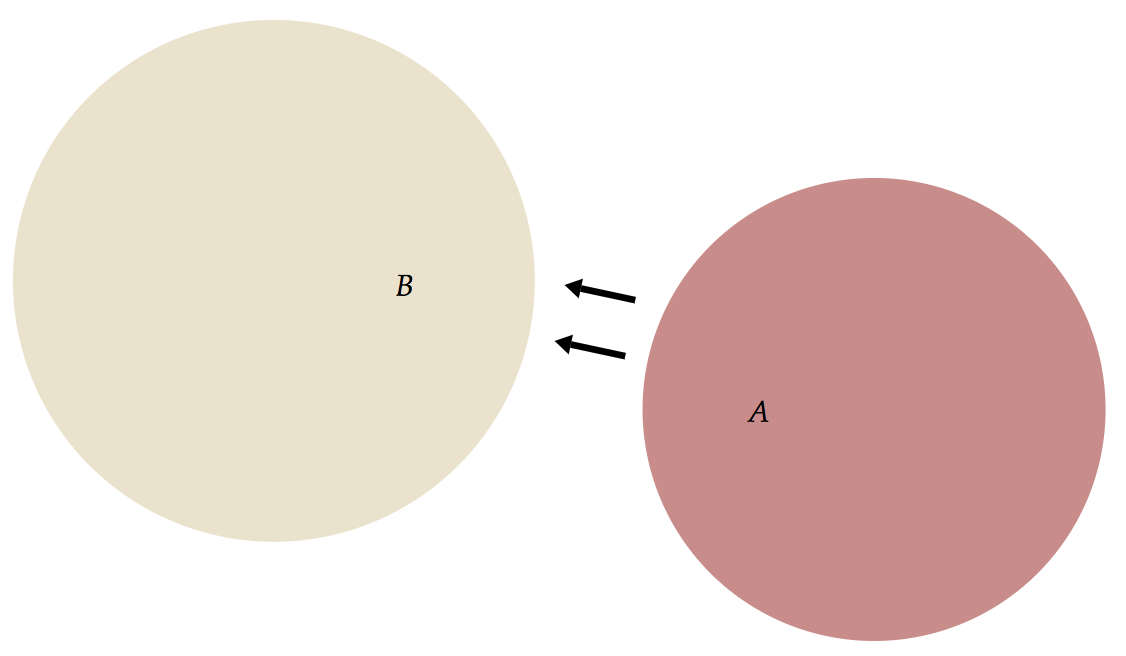
- Now, if we replace
Set XbySet Ain the Style program:
--- Same Substance, different selector in the last block of Style Set A { arr = Arrow { start = A.shape end = B.shape } }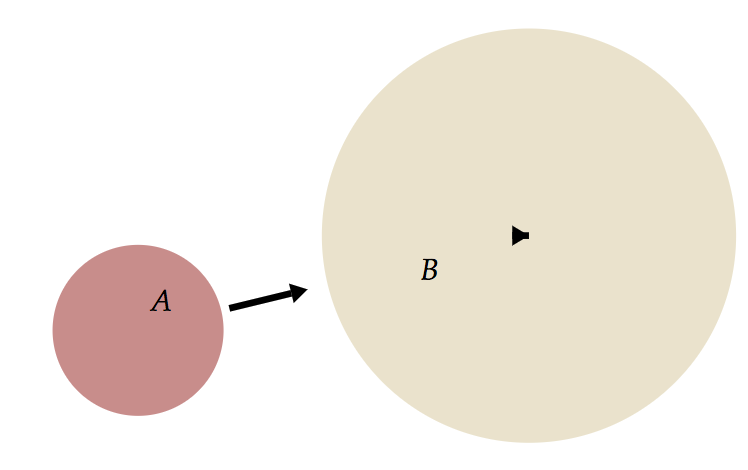
- What's up with the triangle? It's just a very short arrow! Essentially,
Ais an alias for whatever that gets selected now, NOT the Substance id. Therefore, this block says "give me an arrow from myself to a set calledB". InB's case, the arrow points from itself to itself, hence the tiny arrow! Note that no more duplicated arrow in this case.
- For example, if you have the following Substance program
All of the parser code is included in three modules:
-
Substance.hs: Substance's AST, parser, semantic checker -
Style.hs: Style's AST, parser -
Utils.hs: lexer, which is used by both of the modules above
- A Style program is arranged in blocks: a selector followed by a list of statements enclosed in curly brackets
- As a rather arbitrary choice to enforce good structure of code, we end each statement in Style by a newline character ('\n')
- TODO: should we do it the JavaScript way, and allow semicolons as separators, too?
- Technically, the last statement in a block doesn't have to end with newline, because we used
sepEndBy. Therefore,Point x { }will be a valid block.
- As a result, the lexer do not throw away newlines easily. This is evident in
Utils.hs. Search for "Lexer Helper" to begin. - We have two kinds of space consumer:
- the function
scn :: Parser ()will consume all white space characters, including newlines - the function
sc :: Parser ()only consume tabs (\t) and space characters (\)
- the function
- A function
newline' :: Parser ()is therefore defined to be called after parsing a complete statement. It first consumes the newline immediately after the statement, and then callsscnto remove all other white space characters.
A full collection of examples is on the wiki page
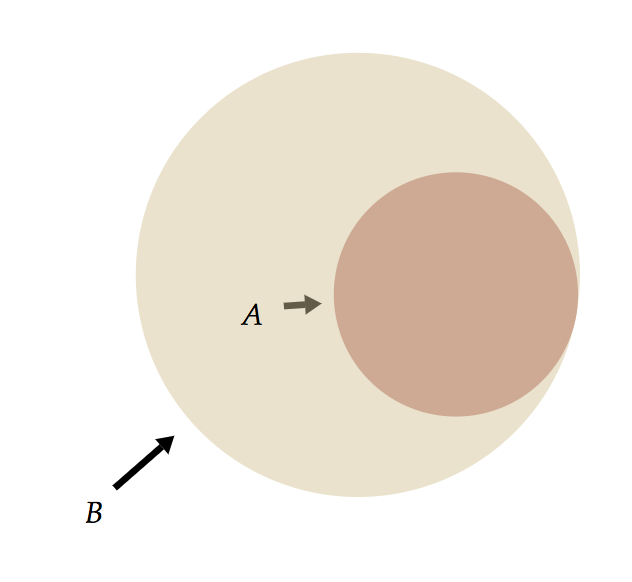
- Run the example:
./runpenrose snap sub/twosets-subset.sub sty/arrow.sty - The relevant part is here:
Set x {
shape = Circle { }
objective outside(x.shape.label, x.shape)
arr = Arrow {
start = x.shape.label
end = x
text = None
}
}
- For every
Set, there are two shapes associated with it, labed asshapeandarr
The list of tokens is defined in SubstanceTokenizer.x. If the lexing fails, try adding any symbols used in the new syntactic sugar to the list of symbols and recompile the system.
- Better internal naming convention for Substance constraints
- Remove predefined properties in
Runtime.hsand come up with a more generalized way to set up required properties in Style - Chained dot access incomplete implementation
- The current implementation of dot access (
.) is incomplete. - Chained access such as
A.arrow.colorwill not work
- The current implementation of dot access (
- Semantic checking for Style: some examples to check
- Wildcard id same as a concrete Substance id?
- Number of patterns different from the number of args that an object takes?
- e.g.:
Subset A, B, C { -- content of the block }should not be permitted
- e.g.:
Found a problem or got a suggestion? Please open a GitHub issue and tag it with documentation!
